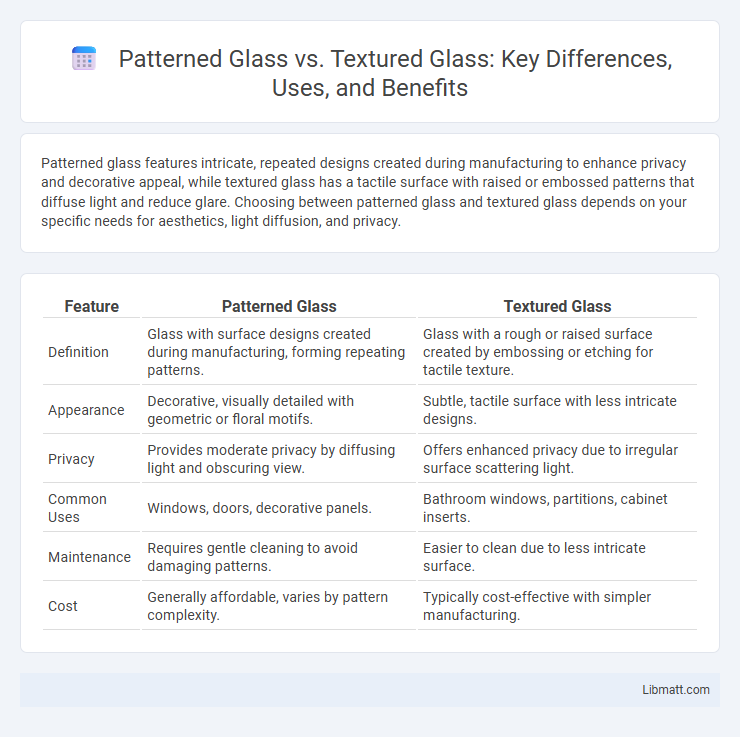Patterned glass features intricate, repeated designs created during manufacturing to enhance privacy and decorative appeal, while textured glass has a tactile surface with raised or embossed patterns that diffuse light and reduce glare. Choosing between patterned glass and textured glass depends on your specific needs for aesthetics, light diffusion, and privacy.
Table of Comparison
| Feature | Patterned Glass | Textured Glass |
|---|---|---|
| Definition | Glass with surface designs created during manufacturing, forming repeating patterns. | Glass with a rough or raised surface created by embossing or etching for tactile texture. |
| Appearance | Decorative, visually detailed with geometric or floral motifs. | Subtle, tactile surface with less intricate designs. |
| Privacy | Provides moderate privacy by diffusing light and obscuring view. | Offers enhanced privacy due to irregular surface scattering light. |
| Common Uses | Windows, doors, decorative panels. | Bathroom windows, partitions, cabinet inserts. |
| Maintenance | Requires gentle cleaning to avoid damaging patterns. | Easier to clean due to less intricate surface. |
| Cost | Generally affordable, varies by pattern complexity. | Typically cost-effective with simpler manufacturing. |
Introduction to Patterned and Textured Glass
Patterned glass features deliberate designs embossed or etched onto its surface, creating distinct visual effects that enhance privacy and aesthetics. Textured glass encompasses a broader range of surfaces with varied relief patterns that diffuse light uniquely while maintaining translucency. Both types serve functional and decorative purposes in architectural and interior applications, providing privacy without compromising natural light transmission.
What is Patterned Glass?
Patterned glass features a consistent, repeating design embossed onto its surface, offering both decorative appeal and privacy by diffusing light. It is commonly used in doors, windows, and partitions to enhance aesthetics while obscuring visibility. This type of glass combines functionality with stylish patterns such as florals, geometric shapes, or abstract motifs.
Defining Textured Glass
Textured glass is characterized by a surface that has been embossed or molded to produce various patterns or designs, enhancing privacy while allowing light transmission. Unlike patterned glass, which often features repetitive motifs or printed designs, textured glass emphasizes tactile and visual depth through raised or indented surfaces. Common applications include bathroom windows, shower doors, and decorative partitions, where both aesthetics and diffused light are essential.
Key Differences Between Patterned and Textured Glass
Patterned glass features specific, often repetitive designs embedded during manufacturing, enhancing aesthetics and privacy while allowing light transmission. Textured glass, on the other hand, has a tactile surface created by mechanical processes like rolling or embossing, providing grip and diffusing light without distinct patterns. The primary difference lies in patterned glass's decorative motifs versus textured glass's focus on surface roughness and functional light diffusion.
Aesthetic Appeal: Design Versatility
Patterned glass offers intricate, repeatable designs that enhance architectural aesthetics by providing consistent visual texture and light diffusion. Textured glass features varied surface treatments, such as hammered or rippled finishes, creating unique depth and tactile interest that complement diverse design styles. Both options increase design versatility by allowing customization in transparency and pattern complexity to suit residential, commercial, or decorative applications.
Privacy and Light Diffusion Capabilities
Patterned glass offers enhanced privacy by incorporating intricate designs that obscure visibility while allowing ample natural light to pass through, making it ideal for maintaining brightness without compromising confidentiality. Textured glass provides superior light diffusion by scattering light uniformly, reducing glare and creating a softer ambiance, but may offer varying levels of privacy depending on the texture's density. Selecting between patterned and textured glass depends on balancing the need for privacy with desired light diffusion effects in residential or commercial applications.
Common Applications in Architecture and Interior Design
Patterned glass is frequently used in architectural facades and office partitions for its ability to provide privacy without sacrificing natural light, making it ideal for conference rooms and exterior windows. Textured glass commonly appears in interior design elements such as shower enclosures, cabinet doors, and decorative panels due to its tactile surface and aesthetic appeal. Your choice between patterned and textured glass can enhance both functionality and style in residential or commercial spaces, depending on the level of opacity and design complexity required.
Durability and Maintenance Considerations
Patterned glass offers enhanced durability due to its thicker, reinforced surface, making it resistant to scratches and impact damage compared to textured glass. Maintenance of patterned glass is generally easier because its uniform design prevents dirt buildup, allowing for straightforward cleaning with standard glass cleaners. Textured glass, while aesthetically pleasing, may require more frequent cleaning and careful maintenance to avoid damage from abrasive materials lodged in its grooves or patterns.
Cost Comparison: Patterned vs. Textured Glass
Patterned glass generally costs more than textured glass due to the intricate designs created during manufacturing, which require specialized molds and processes. Textured glass, featuring simpler surface variations, is typically more affordable and widely available. Budget-conscious projects often favor textured glass for its cost-effectiveness without compromising aesthetic appeal.
Choosing the Right Glass Type for Your Project
Patterned glass features repetitive, decorative motifs that enhance privacy while allowing light diffusion, making it ideal for interior partitions and cabinet doors. Textured glass offers a more varied surface finish that adds tactile interest and obscures vision without compromising natural light, suitable for bathroom windows and office spaces. When selecting glass for your project, consider the desired level of opacity, aesthetic appeal, and functionality to ensure your choice aligns with both design and privacy requirements.
patterned glass vs textured glass Infographic

 libmatt.com
libmatt.com